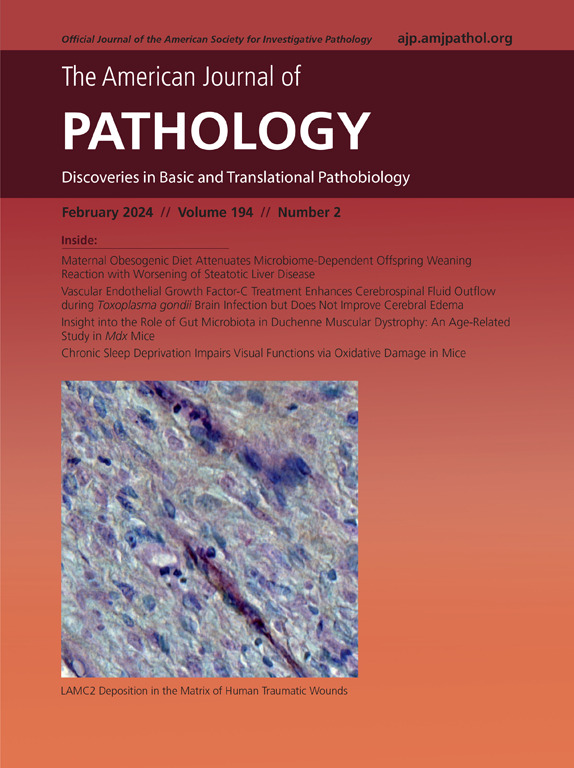Kir5.1(Kcnj16)通道在调节达尔盐敏感大鼠代谢性酸中毒期间肾脏氨代谢中的作用
IF 4.7
2区 医学
Q1 PATHOLOGY
引用次数: 0
摘要
维持酸碱平衡对正常生理功能至关重要。肾脏是通过维持全身碳酸氢盐浓度来调节酸碱平衡的重要器官。慢性代谢性酸中毒是慢性肾脏疾病的一个独立风险因素。肾脏内向整流钾通道 Kir5.1 在维持静息膜电位方面发挥着重要作用。编码 Kir5.1 的 KCNJ16 基因发生功能缺失突变的患者会出现低钾血症、盐耗竭和听力损失等肾小管病变。重要的是,这些基因突变还会破坏酸碱平衡,尤其是导致代谢性酸中毒。本研究旨在利用敲除 Kcnj16 基因(SSKcnj16-/-)的 Dahl 盐敏感大鼠,研究 Kir5.1 基因缺失如何影响盐敏感高血压患者的酸碱平衡调节。结果表明,SSKcnj16-/-大鼠在正常盐(NS)饮食下表现出代谢性酸中毒。使用 RNA-Sequncing 和 Western 印迹技术进行的进一步分析表明,尽管观察到了酸中毒,但 SSKcnj16-/- 大鼠肾脏中负责氨代谢的蛋白质表达没有变化。然而,碳酸氢盐转运体 NBCe1 的表达明显增加,而 pendrin 的表达则明显减少。总之,目前的研究表明,Kir5.1的缺失会损害肾脏中氨代谢对代谢性酸中毒的敏感性,这为开发涉及低钾血症和酸碱异常的潜在疗法提供了机理上的启示。本文章由计算机程序翻译,如有差异,请以英文原文为准。
Role of Kir5.1 (Kcnj16) Channels in Regulating Renal Ammonia Metabolism during Metabolic Acidosis in Dahl Salt-Sensitive Rats
Maintaining acid–base homeostasis is critical for normal physiological function. The kidneys are essential for regulating acid–base homeostasis through maintaining systemic bicarbonate concentration. Chronic metabolic acidosis is an independent risk factor for chronic kidney diseases. Renal inwardly rectifying potassium channel Kir5.1 plays an essential role in maintaining resting membrane potential. Patients with loss-of-function mutations in the KCNJ16 gene, which encodes Kir5.1, may have tubulopathy with hypokalemia, salt wasting, and hearing loss. Importantly, these mutations also disrupt acid–base balance, particularly causing metabolic acidosis. This study aimed to use Dahl salt-sensitive rats with a knockout of the Kcnj16 gene (SSKcnj16−/−) to investigate how the deletion of Kir5.1 affects the regulation of acid–base balance in salt-sensitive hypertension. SSKcnj16−/− rats displayed metabolic acidosis under a normal salt diet. Further analysis using RNA sequencing and Western blot analyses showed unchanged expression of proteins responsible for ammonia metabolism in the kidney of SSKcnj16−/− rats despite observed acidosis. However, there was a significant increase in the expression of bicarbonate transporter NBCe1, where there was a significant decrease in pendrin. In conclusion, the current study demonstrated that the loss of Kir5.1 impairs the sensitivity of ammonia metabolism in the kidney in response to metabolic acidosis, which provides mechanistic insights into developing potential therapeutics for conditions involving hypokalemia and acid–base abnormalities.
求助全文
通过发布文献求助,成功后即可免费获取论文全文。
去求助
来源期刊
CiteScore
11.40
自引率
0.00%
发文量
178
审稿时长
30 days
期刊介绍:
The American Journal of Pathology, official journal of the American Society for Investigative Pathology, published by Elsevier, Inc., seeks high-quality original research reports, reviews, and commentaries related to the molecular and cellular basis of disease. The editors will consider basic, translational, and clinical investigations that directly address mechanisms of pathogenesis or provide a foundation for future mechanistic inquiries. Examples of such foundational investigations include data mining, identification of biomarkers, molecular pathology, and discovery research. Foundational studies that incorporate deep learning and artificial intelligence are also welcome. High priority is given to studies of human disease and relevant experimental models using molecular, cellular, and organismal approaches.

 求助内容:
求助内容: 应助结果提醒方式:
应助结果提醒方式:


